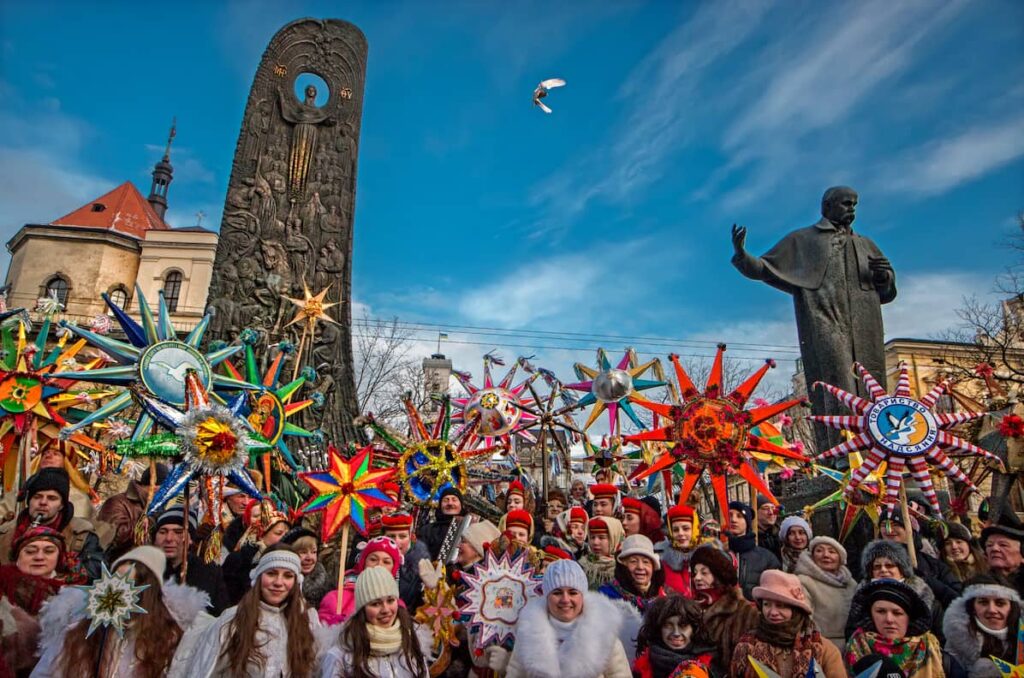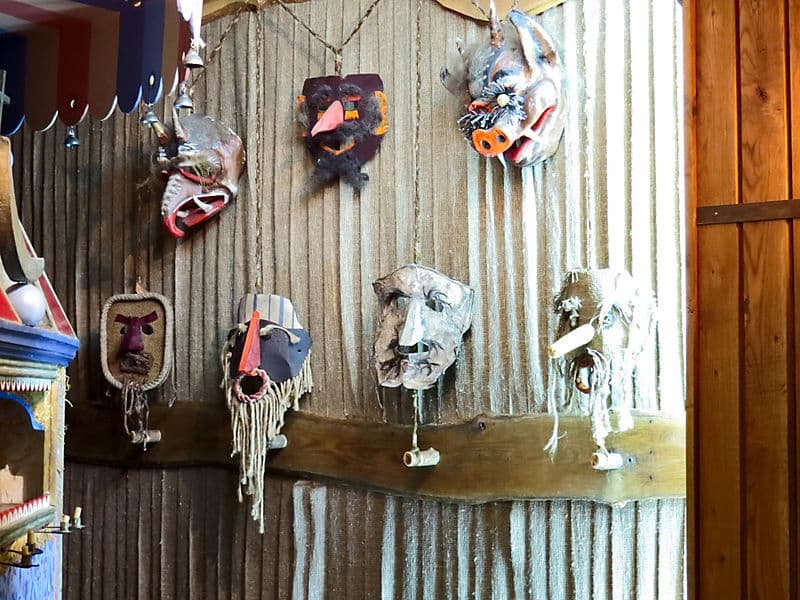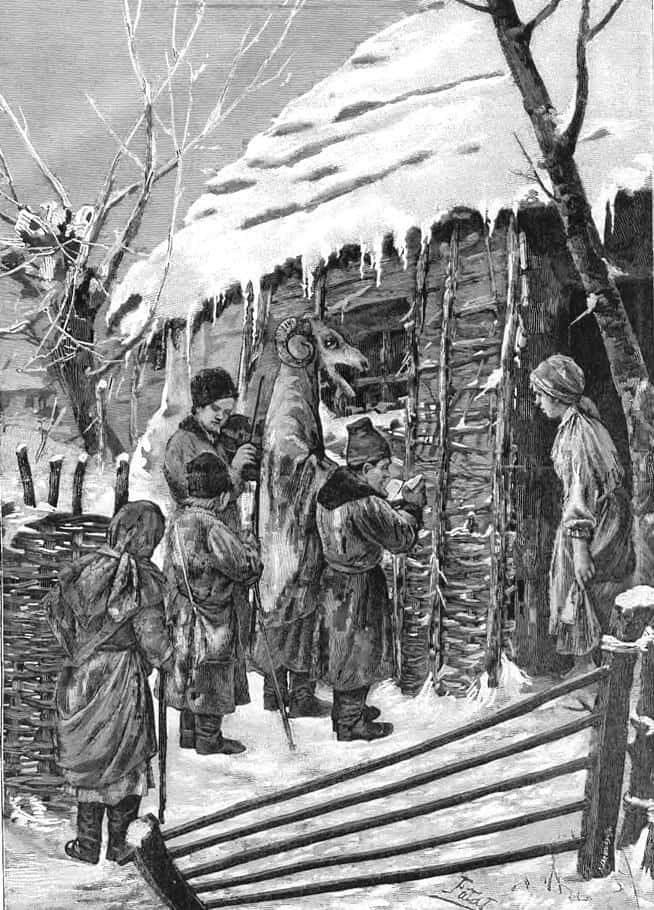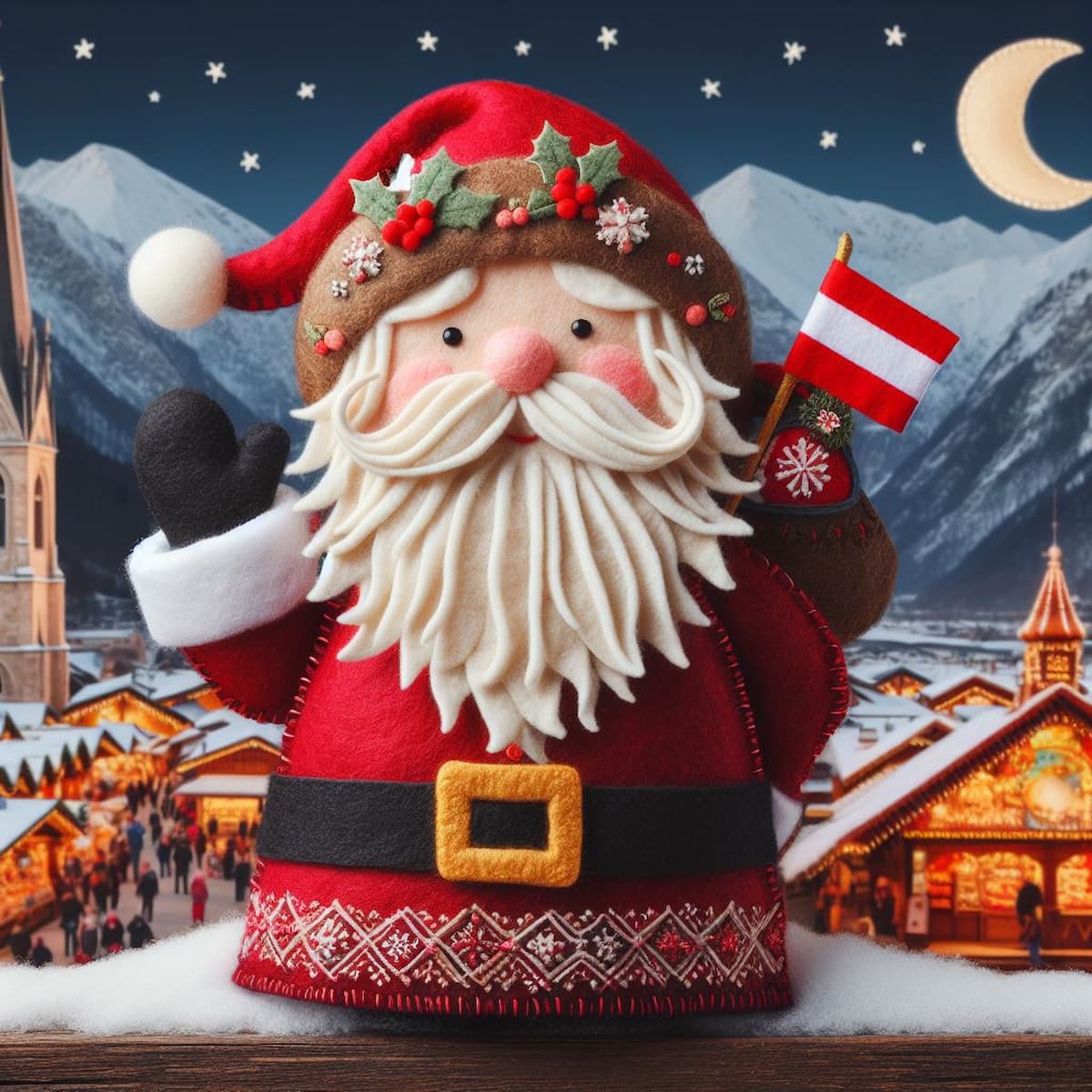During the winter solstice, Ukrainians celebrate the Christian festival of Christmas from December 24th until January 6th. As part of their ancient traditions, Ukrainians display a wide range of folk-dramatic inventiveness throughout Christmas. They observe Christmas Day as a public holiday on December 25. The centerpiece of the festivities is the Holy Supper, also known as the “Sviata Vecheria,” which begins with the first star sighting and has twelve courses representing the twelve apostles. Kutia, a puffed wheat, is the main Christmas course. As a piece of home décor, the didukh—a bundle of wheat stalks representing the souls of the ancestors—is displayed in the country.
-> See also: 48 Countries That Celebrate Christmas Widely
Christmas’ Progression in Ukraine
Being Ready
A 40-day fast, beginning on November 15 and ending on December 25, is a customary practice in Ukraine before Christmas. Saint Apostle Philip’s memorial day falls on the final day of the fast, thus the name “Pylypivka.” A fast is a time of spiritual and bodily cleansing when one refrains from sinful indulgences and practices repentance.
On the eve of Christmas, according to Ukrainian folklore, it was traditional to clean the home, resupply household equipment, and gather all the resources needed for the winter, such as firewood, cloth, wheat, honey, and more. New or clean towels and herbs were introduced to the Christian ritual of decorating icons before Christmas.
The Koliada and Holy Evening

Holy Evening, or Sviatvechir (“Chhristmas Eve”), is Wednesday, December 24th in Ukraine, and Koliada (“Christmas Day”) is the night of December 24th and 25th.
The Holy Evening is not complete without the joyous feast in Ukraine. The number of months is used to determine the number of vegetarian meals (“lenten”) cooked for supper, which ranges from 12 in certain parts of Ukraine to 17. The Ukrainian national cuisine is “rich kutia,” which consists of boiling barley or wheat cooked with honey and several plant components. “Rich kutia” originally had a mystical meaning: it was a symbol of the household’s prosperity sent to the deity Veles (a Slavic god) in the hopes of a plentiful crop the next year.
Although the specific sequence in which the twelve courses are served varies throughout areas of Ukraine, kutia is always served first. Traditionally, dinner was served from shared bowls and two bowls were left empty: for the dead and for the absent family members. A prayer is spoken to start the joyous meal. In remembrance of their departed ancestors, the Ukrainians light a Christmas candle on the table. Around the festive table, the whole family congregates, including the youngest members.
Magical rituals with a pagan background could often be performed at Ukrainian Christmas celebrations in order to bring good fortune to the household, protect it from future calamities, and even foretell the destiny of individual family members. It is also common practice to provide a supper for the destitute and lonely on Christmas Eve. Caroling starts after supper and consists of congratulatory and festive songs that wish the hosts success and announce the birth of Christ.
The original Koliada was a paganism Slavic celebration of the new year. The ancestors’ souls, or “didi,” were thought to pay a visit to their surviving kin on this night. A sheaf of grain that has been gathered and brought into the home before supper is termed a “didukh” and is related to the “didi” picture. It was common for both Ukrainian boys and men to sing carols, with the latter representing the “didi” (old men with gray hair). Modern customs have expanded caroling to include girls and women.
Christmas Day
Family members who attended the midnight church service would greet those who stayed at home on Christmas morning, followed by a collective prayer and breakfast. With the unique greeting “Christ is born!” received on Christmas morning, the response is “Let us glorify Him!” Church services with joyful prayers and visits to family are commonplace on this day. Meat and other heavy foods are once again permissible when the fast concludes on December 25.
Christmas carolers sometimes wear elaborate costumes, including a gilded, paper-covered pole with a big star above it. In it, they see the Star of Bethlehem, which announced the arrival of the Messiah. While visiting houses, carolers ask for permission to sing carols. If the hosts give their consent, the carolers will sing songs and put on comedic scenarios, which the homeowners will then reward with money or sweets.
Common Christmas Practices in Ukraine
Caroling
The boys were the primary organizers of Christmas caroling groups in Ukraine. Prior to the event, they would choose a leader or “vataga,” and assign others duties such as “goat,” “shepherd with a scarecrow,” “mikhonosha” (deacon), and more. In certain parts of Ukraine, the “goat” would wear an inside-out sheepskin coat and be adorned with straw horns, a tail, and a bell around its neck.
In other parts of the country, variants existed, with “gypsy,” “doctor,” “Jew,” “death with a scythe,” and other figures appearing. The headman, however, was required to wear a moveable star at all times (Bereza). There are many different kinds of carols sung by Ukrainian girls and boys, as well as by adults. Caroling for cattle is also recognized in Polesia.
Carolers start their performance with celebratory songs and comedic moments after asking permission to carol when they approach a courtyard. In poetic works, the host, hostess, and children are praised and bestowed with well-wishes for health, happiness, and domestic wealth.
Up until Epiphany (January 6), contemporary caroling is still practiced throughout much of Ukraine. Nevertheless, up until around the middle of the past century, carolers would visit houses in Kyiv and the surrounding areas until the Feast of the Presentation of Jesus at the Temple, which is on February 2.
Vertep: Puppet Theater for the Nativity

“Living Vertep” is a popular Christmas show in Ukraine and it’s a unique Christmas tradition in the country. It is an old kind of moveable puppet theater that can perform both secular and religious performances. Since its inception, the Vertep has evolved from a puppet show into a full-fledged street theater, where human actors augment the puppet show’s traditional puppetry and, at some sections, take center stage.
There are two sections to a Vertep performance. Jesus’ birth, as told in the Bible, is the first. Part two is an everyday satire interlude. Sharing the news of Jesus’ birth with people is the primary goal of the Vertep. The Vertep’s crowning ornament, the Christmas star, represents the star that told the wise men of Israel about the birth of Jesus Christ.
Nativity Play

The dramatization of the events surrounding Jesus’ birth is known as a Nativity play or Christmas pageant. Christmas, the feast of the Nativity, is the traditional time to conduct it in Ukraine because on Christmas Eve 1223, Saint Francis of Assisi allegedly celebrated Midnight Mass in Greccio in front of a huge nativity scene (crib or creche) constructed by Giovanni Velita, complete with real animals. Preceding the Christmas holiday, a Nativity play is performed by primary schools and Sunday schools, particularly those with a Christian focus, in Ukraine.
Malanka, a Merry Game

On Christmas Eve, January 13 (according to the Julian calendar), the “Malanka” is performed in Ukraine, which is also known as “driving a goat” in the country. The goat’s “death” and “resurrection” dance symbolize the natural cycle of decay and it’s also known as capra (goat dance) in Romanian regions.
In this Ukrainian folk celebration, an older guy in a mask, a Jew, a goat, a gypsy, a fershal, and Malanka herself make the whole team, and they drive a goat from house to house to bring good luck. In Western Ukraine and Romania, people use a dancer in a goat costume instead of a live goat.
Ukrainian Holidays Related to Christmas
Day of Mary – December 26
The Ukrainian church calendar recognizes the second day of Christmas (December 26) as the Synaxis of the Most Holy Theotokos (title given to Mary), and on that day, “Mary’s Day”, they celebrate in honor of the Holy Family (Jesus, Mary, and Joseph).
While no special ceremonies are observed on these days, Ukrainians still enjoy singing carols, reenacting the nativity scene, and paying tribute to Mary, the patron saint of their religion.
Generous Evening – December 31
The second Christmas holiday, Generous Evening, takes place on December 31, one week after Christmas. The Christian saint Melania is celebrated on the feast day of Generous Evening. Melanka is another name for this day. As part of the festivities, it is customary to visit people’s homes and deliver New Year’s greetings along with health, wealth, and happiness. Theatrical ensembles “Melanka,” “Vasyl,” and “Mummers” (a Christmas-time house-visiting tradition) are also present at the festivities.
Festivity at Malanka – January 13
Monastyryshche is well-known for its Malanka celebration, which is also well preserved in the Transnistrian district of Ternopil. The origins of the “Malanka” rite are not in the Christian era. Traditionally, the celebrations revolved around special food and drink and house-to-house visits by groups of young men dressed as figures from a pre-Christian folk story. Although the setting for the rites has evolved, many of its components have persisted to this day.
Epiphany in Jordan – January 19
Epiphany, also known as the Blessing of Water, is the third and final celebration after Christmas in Ukraine. The traditional name of the festival, Jordan, or Yordan, meaning “sunbathing water,” suggests that it is connected to the worship of water and Jordan (“Theophany”). As Christianity spread, the name took on a new connotation and, by phonetic association, came to be linked to Jesus Christ’s baptism in the Jordan River. While the Ukrainian Epiphany festival was mostly dormant under Soviet rule, it made a triumphant return in the 1990s.
New Year: Vasily’s Day – February 14
February 14 is celebrated as “Old New Year” or “Vasily’s Day” in Ukraine. Saint Basil the Great Day is another name for this day in the Christian calendar. The family prepares buckwheat porridge first thing in the morning on this day in order to see into the future. They also create dumplings with a variety of fillings.
The whole Ukranian family is tasked with shaping them, and the hostess discreetly places a penny into one of them. Whoever obtains it will have a life of plenty in the years to come. Coins are also turned into pies by them. It is traditional to go sowing in the morning of January 14. On Vasily’s Day, boys of all ages visit each home, welcoming the hosts with poetry and leaving grain on the door.
History of the Christmas Date in Ukraine
85% of Ukrainians are Christians, and 72% of them are Orthodox. Orthodox Christians, Greek Catholics, and other Christians of the Eastern rite commemorated Christmas on January 7 until 2022, when the Julian calendar was in use. Observers of the Gregorian calendar (Western-rite Roman Catholics and Protestants) and the new Julian calendar (certain Orthodox parishes) commemorated December 25.
The question of shifting the celebration to December 25 based on the new Julian and Gregorian calendars has been hotly debated every year in Ukraine since the beginning of the Russo-Ukrainian War in 2014 and December 25 finally became a public holiday in Ukraine in 2017 according to the Gregorian calendar. In 2022, when Russia invaded Ukraine on a massive scale, the question of calendar change became even more pressing.
The 20th and 21st centuries are characterized by the practice of celebrating Christmas on January 7 in Ukraine. Assuming the calendar remains unchanged until the 22nd century, this day will be January 8 at that time, compared to January 6 in the 19th. This would allow all Ukrainian Christians to celebrate Christmas on the same day as the majority of Christians worldwide.
In December 2020, Metropolitan Epiphanius, leader of the Ukrainian Orthodox Church, said that the church would be prepared to consider such a date shift in Ukraine. All fixed holidays would have to be rescheduled thirteen days in advance if Christmas were to be moved. In December 2020, Patriarch Sviatoslav of the Ukrainian Greek Catholic Church said that the ECC will deal with this “together with our Orthodox brothers.”
Similar to the Romanian Orthodox Church, around one hundred parishes of the Romanian minority in Ukraine that are members of the Moscow Patriarchate have traditionally observed Christmas on December 25th in accordance with the new Julian calendar.
The Ukrainian Orthodox Church officially approved the new Julian calendar on October 18, 2022, allowing Christmas to be celebrated on December 25. At its meeting, the Holy Synod quickly reached the resolution. Full adoption of the Julian calendar was sanctioned by the Holy Synod of the Ukrainian Orthodox Church on February 2, 2023.
During its meeting in Lviv-Brukhovychi on February 1-2, 2023, the Hierarchical Synod of the UGCC (Ukrainian Greek Catholic Church) decreed that the Ukrainian Greek Catholic Church in Ukraine would begin celebrating Christmas on December 25th and transition to the new style (new Julian calendar) on September 1, 2023. The Orthodox Church of Ukraine switched to the Julian calendar (apart from Easter) starting on September 1, 2023, as per a decision passed in the Hierarchical Council on May 24, 2023, at the Kyiv-Pechersk Lavra.
The Ukrainian President Volodymyr Zelensky presented a measure to the Verkhovna Rada (Ukrainian Parliament) on June 28, 2023, that would do away with the January 7 Christmas holiday. The Verkhovna Rada approved the measure on July 14, 2023.
-> See also: All 15 Countries That Don’t Celebrate Christmas






